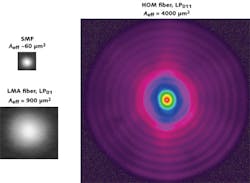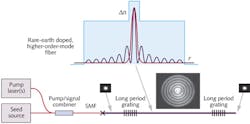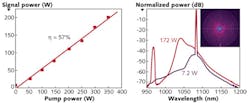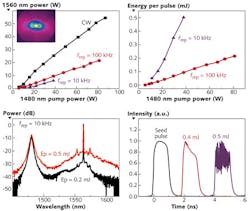FIBER AMPLIFIERS: Higher-order modes expand optical fiber amplifier performance
JEFFREY NICHOLSON, JOHN FINI, CLIFFORD HEADLEY, ANTHONY DeSANTOLO, and XIAOPING LIU
High-power fiber lasers offer several advantages over conventional solid-state lasers, such as beams with stable transverse modal properties; simple thermal management resulting from the large surface-area-to-volume ratio; and lightweight, rugged, and compact packaging. But the advantages of optical fiber amplification also come with drawbacks. The long operating lengths and waveguide geometry can lead to optical nonlinearities such as stimulated Brillouin and Raman scattering and self-phase modulation that ultimately limit scalability of high-power lasers.
Increasing the effective area of the operating mode leads to a corresponding decrease in nonlinearity, and many efforts have focused on different approaches to increasing the size of the fundamental (LP01) mode. One solution is to simply increase the core size of a conventional fiber design. In principle, this can increase mode effective area while maintaining singlemode operation, but only if the index contrast of the core is extremely low. Such a fiber is extremely bend-sensitive, and so the fiber must be made rigid and held straight. These rod-type fibers are successful at power scaling but eliminate much of the benefits of the fiber geometry such as compact packaging with a coiled amplifier, and simple fusion splicing to other optical fibers.1
Another approach is to increase the index contrast and operate in the fundamental mode of a fiber that is not truly singlemoded, and strip the unwanted higher-order modes using various means, allowing larger mode area as well as effective singlemode operation. Holes and rods placed in the fiber cladding to create leakage channels for higher-order modes, helically coiled cores, or a chirally coiled second core surrounding a straight core are also being actively pursued.2-4 A fiber amplifier operating in the fundamental mode, however, still suffers from significant limitations. First, the fundamental mode becomes increasingly unstable as its size increases. And second, when an optical fiber is coiled, bend-induced changes in the refractive index can lead to a large decrease in the effective area of the fundamental mode, negating the benefit of designing fibers with ultralarge fundamental mode effective areas.
The HOM route to high-power, low-nonlinearity amplification
An alternative approach pioneered at OFS Laboratories is to design a fiber that supports many modes and then operates in a single, specifically chosen higher-order mode (HOM).5 Such HOM fibers allow for dramatic increases in effective area-up to 4000 μm2 compared to 900 μm2 with conventional large-mode-area (LMA) fibers—and enable amplification with low levels of nonlinearity (see Fig. 1).
Successful amplification of these very large area modes is possible because higher-order modes have some surprising and somewhat counter-intuitive benefits. They are less susceptible to mode coupling caused by typical perturbations to optical fibers compared to a fundamental mode with the same area, resulting in substantially lower levels of unwanted modal content and a more stable output beam. And they are less sensitive to area reductions caused by bending. For example, a fiber with an LP01 mode designed to have an effective area (Aeff) of 2000 μm2 when held straight would have a 75% reduction in area when the fiber was coiled to a bend diameter of 15 cm. However an LP07 mode would only reduce in area by 3% under similar conditions. Finally, HOM fibers with ultralarge area can be fabricated that are amenable to simple fusion splicing to standard singlemode fibers.
HOM amplifiers
In an amplification setup, the central peak in the refractive-index profile of an HOM fiber guides the fundamental mode and is designed to be of similar size and shape to the mode of standard singlemode fiber for optimized fusion splicing (see Fig. 2). The higher-order modes are guided in an outer core region that can have a diameter of 150 μm, or even larger. The fiber is doped with a rare-earth to provide gain. Coupling with high purity (better than 99%), and selectivity between the fundamental mode and the desired HOM is accomplished using phase matching with a long-period grating (LPG).The pump and signal beam are coupled together using an appropriate combiner and launched together into the HOM fiber. The LPG converts the signal from fundamental mode to higher-order mode and the signal is amplified while propagating in the higher-order mode. At the exit, the signal is reconverted back to the fundamental mode, either with a second matching grating or a bulk-optical element such as a phase plate.
It is worth noting that mathematically, a high-order mode from an ideal step-index cylindrically symmetric waveguide is a truncated Bessel function of the first kind, which has some inherently useful properties as a high-power optical beam. These beams are often referred to as "diffraction free" because the central spot propagates for long distances with high intensity, and Bessel beams are frequently generated in free space using optical elements such as axicons. A HOM fiber amplifier offers an elegant, integrated approach to generating Bessel beams with high power and excellent modal purity for applications as diverse as long depth-of-focus microscopy, micromachining, and optical tweezing.
CW and pulsed amplification
At OFS both ytterbium (Yb)- and erbium (Er)-doped HOM amplifiers have been demonstrated.6 For the Yb-doped HOM amplifier, high-power multimode pumps were coupled together using a tapered-fiber bundle. The HOM fiber was low-index coated for cladding pumping and operated in the LP09 mode with an effective area of 3300 μm2, generating 200 W output power in the higher-order mode for a 9.5 m fiber, with excellent modal quality (see Fig. 3). In a second experiment an amplifier was tested with an additional output long-period grating reconverting the light back to the fundamental mode. Here, 46 W of 1080 nm signal power was obtained for 90 W of pump power, demonstrating the ability of HOMs to achieve high continuous-wave (CW) power and perform reconversion back to the fundamental mode with high fidelity.In the case of Er-doped fibers, our focus has been on high-pulse-energy amplification. Because of the large effective areas achievable, higher order modes are ideal for high-peak-power pulses and large pulse energies that are useful in a wide range of applications, including nonlinear optics, micromachining, laser ranging, and remote sensing.
Cladding pumping of Er-doped amplifiers is difficult due to low absorption and lack of ideal pump sources. Therefore, to pump Er-doped HOM amplifiers, OFS has developed a high-power, 1480 nm singlemode Raman fiber laser with more than 100 W of singlemode CW output, ideal for core-pumping Yb-free, Er-doped fibers. This 1480 nm Raman fiber laser is combined with the pulsed signal source at 1550 nm using a singlemode fused-fiber wavelength-division multiplexer (WDM). Both pump and signal are then converted to the same higher-order mode using a single, ultrabroadband LPG. Because pump and signal co-propagate in the same mode, pump-signal overlap is nearly perfect, which allows for the use of short (few meter) fiber lengths and also helps further suppress unwanted extraneous higher-order modes.
Initial experiments on Er-doped HOM amplifiers with 2400 μm2 effective area generated 100 kW peak power pulses. Compared to amplification in the same length (4 m), same erbium absorption (30 dB/m at 1530 nm) conventional LMA Er-doped fiber with 880 μm2 effective area, the HOM amplifier achieved three times the pulse energy for the same level of nonlinearity.7
More recently a CW-seeded Er-doped HOM amplifier with a 6000 μm2 effective area generated 55 W in the LP014 mode at 1560 nm (see Fig. 4).8 With nanosecond seed pulses, pulse energies as high as 0.5 mJ with peak power of 0.5 MW for a 10 kHz pulse train were achieved—a record peak power for an Er-doped amplifier operating in a single transverse mode. At these pulse peak powers, nonlinear spectral components and noise in the pulse due to modulation instability can be seen both in the output optical spectrum and output pulses.Optical fiber amplifiers with unprecedented effective areas are enabled by the use of higher-order modes. At the same time as the effective area is maximized, the desirable aspects of an optical fiber are maintained, such as compact packaging using a coilable optical fiber and robust optical alignment using fusion-spliced components. The demonstrated cladding-pumped Yb-doped and core-pumped Er-doped HOM amplifiers show high power, low nonlinearity, and great promise for high-power fiber laser architectures. Although the maximum area demonstrated to date for a rare-earth-doped HOM fiber is 6000 μm2, we expect that further scaling to even larger areas can be achieved.
ACKNOWLEDGMENTS
The authors would like to thank P. Wisk, M. Yan, E. Gonzales, V.R. Supradeepa, F. DiMarcello, E. Monberg, B. Mangan, and D.J. DiGiovanni for their contributions and support to this work.
REFERENCES
1. J. Limpert et al., Opt. Expr., 13, 4, 1055–1058 (2005).
2. W.S. Wong et al., Opt. Lett., 30, 21, 2855–2857 (2005).
3. J.R. Marciante, "Mode-area scaling of helical-core dual-clad fiber lasers and amplifiers," CLEO Conf. Publications, 3, 1849–1851 (2005).
4. C.H. Liu, CLEO 2007 conf., paper CtuBB3 (2007).
5. S. Ramachandran et al., Laser & Photon.Rev., 2, 6, 429–448 (December 2008).
6. V.R. Supradeepa et al., Photonics West 2012 LASE conf., paper 8237-48 (2012).
7. J.W. Nicholson et al., CLEO 2010 conf., paper CPDB5 (2010).
8. J.W. Nicholson et al., CLEO 2012 Tech. Dig., paper JTh1I.2 (2012).
Jeffrey Nicholson and John Fini are distinguished members of the technical staff, Clifford Headley is technical manager, Lasers and Amplifiers Group, and Anthony DeSantolo and Xiaoping Liu are members of the technical staff at OFS Laboratories, 19 Schoolhouse Rd., Somerset, NJ 08873; e-mail: [email protected]; www.ofsoptics.com/labs/.



